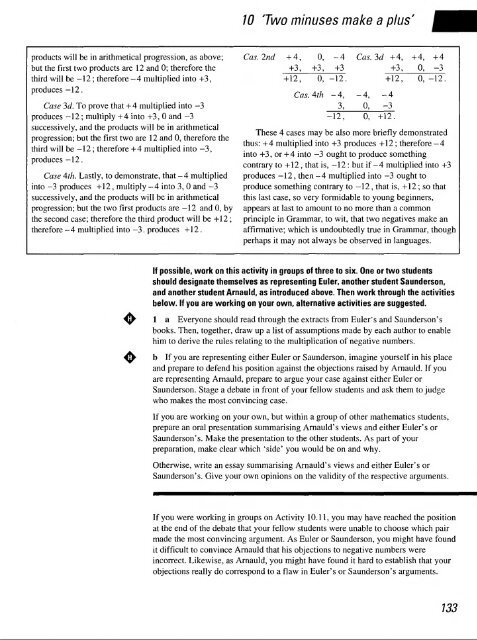history of mathematics - National STEM Centre
history of mathematics - National STEM Centre
history of mathematics - National STEM Centre
Create successful ePaper yourself
Turn your PDF publications into a flip-book with our unique Google optimized e-Paper software.
products will be in arithmetical progression, as above;<br />
but the first two products are 12 and 0; therefore the<br />
third will be -12; therefore -4 multiplied into +3,<br />
produces -12.<br />
Case 3d. To prove that + 4 multiplied into -3<br />
produces -12; multiply + 4 into +3, 0 and -3<br />
successively, and the products will be in arithmetical<br />
progression; but the first two are 12 and 0, therefore the<br />
third will be -12 ; therefore +4 multiplied into -3,<br />
produces -12.<br />
Case 4th. Lastly, to demonstrate, that -4 multiplied<br />
into -3 produces +12, multiply -4 into 3, 0 and -3<br />
successively, and the products will be in arithmetical<br />
progression; but the two first products are -12 and 0, by<br />
the second case; therefore the third product will be +12;<br />
therefore -4 multiplied into -3. produces +12.<br />
10 'Two minuses make a plus'<br />
Cas. 2nd + 4, 0, -4 Cas. 3d + 4, + 4, +4<br />
+3, +3, +3<br />
+3, 0, -3<br />
+12, 0, -12. +12, 0, -12.<br />
Cas. 4th - 4, - 4, - 4<br />
3, 0, -3<br />
-12, 0, +12.<br />
These 4 cases may be also more briefly demonstrated<br />
thus: +4 multiplied into +3 produces +12 ; therefore -4<br />
into +3, or +4 into -3 ought to produce something<br />
contrary to +12, that is, -12: but if-4 multiplied into +3<br />
produces -12, then -4 multiplied into -3 ought to<br />
produce something contrary to -12, that is, +12; so that<br />
this last case, so very formidable to young beginners,<br />
appears at last to amount to no more than a common<br />
principle in Grammar, to wit, that two negatives make an<br />
affirmative; which is undoubtedly true in Grammar, though<br />
perhaps it may not always be observed in languages.<br />
If possible, work on this activity in groups <strong>of</strong> three to six. One or two students<br />
should designate themselves as representing Euler, another student Saunderson,<br />
and another student Arnauld, as introduced above. Then work through the activities<br />
below. If you are working on your own, alternative activities are suggested.<br />
1 a Everyone should read through the extracts from Euler's and Saunderson's<br />
books. Then, together, draw up a list <strong>of</strong> assumptions made by each author to enable<br />
him to derive the rules relating to the multiplication <strong>of</strong> negative numbers.<br />
b If you are representing either Euler or Saunderson, imagine yourself in his place<br />
and prepare to defend his position against the objections raised by Arnauld. If you<br />
are representing Arnauld, prepare to argue your case against either Euler or<br />
Saunderson. Stage a debate in front <strong>of</strong> your fellow students and ask them to judge<br />
who makes the most convincing case.<br />
If you are working on your own, but within a group <strong>of</strong> other <strong>mathematics</strong> students,<br />
prepare an oral presentation summarising Arnauld's views and either Euler's or<br />
Saunderson's. Make the presentation to the other students. As part <strong>of</strong> your<br />
preparation, make clear which 'side' you would be on and why.<br />
Otherwise, write an essay summarising Arnauld's views and either Euler's or<br />
Saunderson's. Give your own opinions on the validity <strong>of</strong> the respective arguments.<br />
If you were working in groups on Activity 10.11, you may have reached the position<br />
at the end <strong>of</strong> the debate that your fellow students were unable to choose which pair<br />
made the most convincing argument. As Euler or Saunderson, you might have found<br />
it difficult to convince Arnauld that his objections to negative numbers were<br />
incorrect. Likewise, as Arnauld, you might have found it hard to establish that your<br />
objections really do correspond to a flaw in Euler's or Saunderson's arguments.<br />
133
















